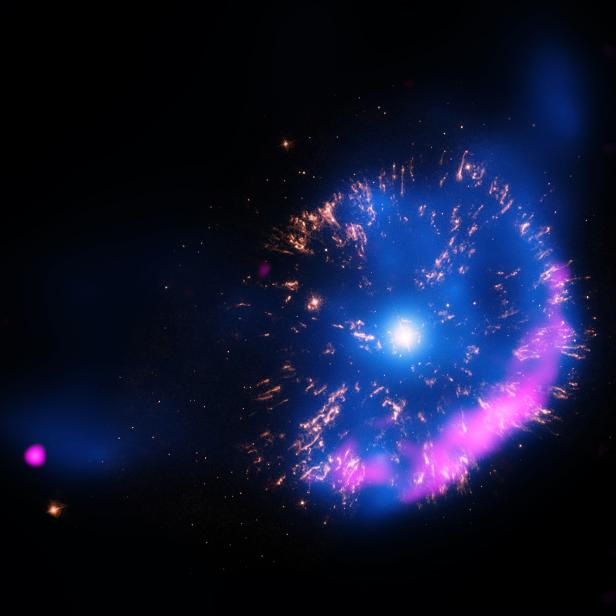
Chandra X-ray Observatory Center
You Love Supernova, So How About Micronova?

In space, even the smallest explosions are insanely powerful. Take for instance the newly discovered “micronova,” which sounds cute and cuddly and not at all deadly…except for the fact that it’s the explosive equivalent of a nuclear bomb a million times bigger than Mount Everest.
Here’s one way to build a nuclear bomb in space. You start with a pair of stars, which is the most common way to find stars, so this is the easy part. Then you have one star age faster than the other. This is also pretty easy, since more massive stars burn through their material at a higher rate, and it’s likely that one of your stars will simply be more massive than the other.
And then you just wait, and time and gravity will do their job.
Okay, so it turns out it’s all easy parts.

ESA/NASA
A bright star is surrounded by a tenuous shell of gas in this unusual image from the NASA/ESA Hubble Space Telescope. U Camelopardalis, or U Cam for short, is a star nearing the end of its life. As it begins to run low on fuel, it is becoming unstable. Every few thousand years, it coughs out a nearly spherical shell of gas as a layer of helium around its core begins to fuse. The gas ejected in the star’s latest eruption is clearly visible in this picture as a faint bubble of gas surrounding the star. U Cam is an example of a carbon star. This is a rare type of star whose atmosphere contains more carbon than oxygen.
The larger star will burn through its available supply of hydrogen and helium and die, leaving behind a core of carbon and oxygen, known as a white dwarf. Eventually, the smaller star will reach the end of its life cycle, swelling to become a red giant.
Occasionally some of the atmosphere of that red giant will swirl onto the white dwarf. If too much gas falls onto the surface, the densities will go critical and the entire white dwarf will undergo a runaway nuclear fusion event, also known as a giant bomb – a supernova.
If just some of the piled-up material ignites without cracking the white dwarf, you get a smaller, weaker explosion, known as a nova. The power behind a nova comes from the rapid fusion of hydrogen into helium, and while not as bright as their supernova cousins, they’re still pretty impressive.

X-ray: NASA/CXC/NCSU/K. Borkowski et al; Optical: DSS
A new look at the debris from an exploded star in our galaxy has astronomers re-examining when the supernova actually happened. Recent observations of the supernova remnant called G11.2-0.3 with NASA’s Chandra X-ray Observatory have stripped away its connection to an event recorded by the Chinese in 386 CE. Historical supernovas and their remnants can be tied to both current astronomical observations as well as historical records of the event. Since it can be difficult to determine from present observations of their remnant exactly when a supernova occurred, historical supernovas provide important information on stellar timelines.
For a long time, astronomers believed that these were your only two options when it came to these kinds of explosions. Either the entire white dwarf goes off (a supernova) or just the gas that piled onto it (a nova).
But NASA’s telescope TESS found something interesting when it was doing its job to hunt for planets orbiting other stars: a bright flash lasting only a few hours. Their interest piqued, some astronomers began searching for similar kinds of flashes, until they found what they were looking for using the European Southern Observatory’s Very Large Telescope.
They found a micronova, which has the same setup as a supernova or regular nova, just…not as powerful. They believe that powerful magnetic fields swirling around the white dwarf prevent gas from the companion red giant from just falling wherever it wants. Instead, it forces the gas to flow onto the poles of the white dwarf. There the gas piles up until it reaches the critical densities required to go nuclear. But since there isn’t an entire atmosphere’s worth of material to blow up, the explosion isn’t as intense as a regular nova.
Still, I wouldn’t go anywhere near it.
Journey Through the Cosmos in an All-New Season of How the Universe Works
The new season premieres on Science Channel and streams on discovery+.




















